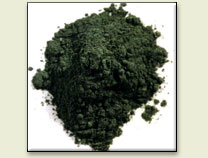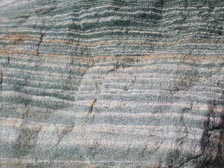How Green earth is made:
| Origin: natural earth | Glauconite or celadonite (at Mineralogy Database) |
Sandstone with abundant dark green glauconite grains. Hudson, St. Croix County, WI. Glauconite has a micaceous structure. It is characteristically formed on submarine elevations of ancient seabeds ranging in depth from 30 to 1,000 meters (100 to 3,300 feet) below sea level, and in the sedimentary rocks of different geological systems. |
|
| Natural variety of pigment | The pigment is produced by grinding the natural material glauconite and celadonite. Indeed, green earth is primarily composed of the minerals celadonite and glauconite which different percentage presence produces colors that vary from cold bluish greens to warmer yellow and olive hues. The most famous deposit of green earth was found near Verona, Italy, and this mine was active until World War II. Other mines produced variations in color and texture of the pigment: Baltic states, Bohemia, Cypress, France, Hungary, Poland, Saxony, Tyrol, and the Mendip hills of England. Our green earth is from from open mines near Mt. Baldo, Italy. |
The ground pigment:
Pile of ground Green earth

Other greens
(intro) - Cobalt green - Copper resinate - Emerald green - Green earth - Malachite - Verdigris - Viridian
(intro) - Cobalt green - Copper resinate - Emerald green - Green earth - Malachite - Verdigris - Viridian


